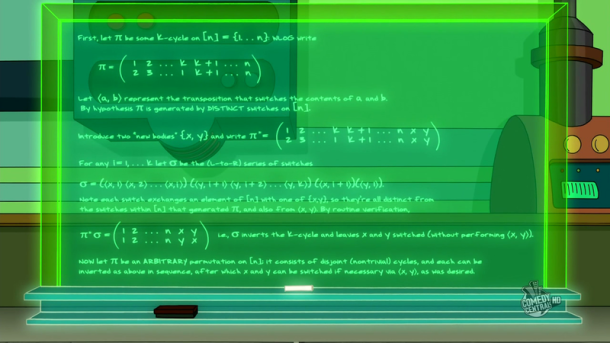The Futurama Theorem (Talk)
On December 7, 2011, I gave my second talk about the Futurama Theorem during a Plymouth State University Mathematics Seminar. The Futurama Theorem is a theorem about the symmetric group that was developed for and proved in the episode “The Prisoner of Benda” for the TV show Futurama. The theorem was proved by show writer Ken Keeler, who has a PhD in applied mathematics from Harvard.

The first time I gave a talk about this theorem was during the Mathematics Forum at Gordon College just few weeks earlier. You can find my blog post about my first talk by going here.
During the episode, Professor Farnsworth and Amy invent a mind swapping machine and after they swap minds, they realize that the machine cannot be used on the same pair of bodies again. After several characters swap minds, they are confronted with the problem of putting everyone’s mind back where it belongs. The Futurama Theorem proves that regardless of how many mind swaps have been made, all minds can be restored to their original bodies using only two extra people. If you want to know more, check out the slides.
The slides for the second talk are very similar to the first set, but there are a few differences:
- The second talk is shorter. I trimmed a few things from the first talk that were not completely necessary.
- I’ve improved the wording in a few spots.
- In the second talk, multiplication of permutations is right to left.
As with the first talk, I used deck.js to create the slides. This allows you to view the slides directly in your web browser. To advance the slides, just use your arrow keys. Also, note that I used MathJax to typeset all of mathematical notation.
Dana C. Ernst
Mathematics & Teaching
Northern Arizona University
Flagstaff, AZ
Website
928.523.6852
Twitter
Instagram
Facebook
Strava
GitHub
arXiv
ResearchGate
LinkedIn
Mendeley
Google Scholar
Impact Story
ORCID
Current Courses
MAT 226: Discrete Math
MAT 690: CGT
About This Site
This website was created using GitHub Pages and Jekyll together with Twitter Bootstrap.
Unless stated otherwise, content on this site is licensed under a Creative Commons Attribution-Share Alike 4.0 International License.
The views expressed on this site are my own and are not necessarily shared by my employer Northern Arizona University.
The source code is on GitHub.
Land Acknowledgement
Flagstaff and NAU sit at the base of the San Francisco Peaks, on homelands sacred to Native Americans throughout the region. The Peaks, which includes Humphreys Peak (12,633 feet), the highest point in Arizona, have religious significance to several Native American tribes. In particular, the Peaks form the Diné (Navajo) sacred mountain of the west, called Dook'o'oosłííd, which means "the summit that never melts". The Hopi name for the Peaks is Nuva'tukya'ovi, which translates to "place-of-snow-on-the-very-top". The land in the area surrounding Flagstaff is the ancestral homeland of the Hopi, Ndee/Nnēē (Western Apache), Yavapai, A:shiwi (Zuni Pueblo), and Diné (Navajo). We honor their past, present, and future generations, who have lived here for millennia and will forever call this place home.
